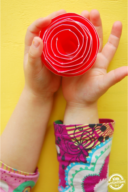In this post, I’m gonna turn you into an expert on how to build your own terrarium! Just what is a terrarium? A terrarium is an enclosed glass garden that is small enough to fit into your decor!
Terrariums bring the wonders of plants into the home, in a way that is easy to manage. Conserving water and allowing natural mini-ecosystems to form is just part of the magic of a terrarium. Learning how to make a terrarium is a gateway to happy, thriving plants.

How to Make a Terrarium
Making your very own terrarium is easy! I would suggest starting small. You can make a mini terrarium with jars or vases, before moving to more complicated terrariums. This helps you to build your confidence! And small terrarium plants can always be moved to bigger terrariums as you develop your skills.
(Post contains affiliate links.)
Terrarium Supplies

- Pea Gravel
- Soil
- Lump Charcoal or Activated Carbon (DO NOT USE CHARCOAL BRIQUETTES)
- Window Screen or similar, non-biodegradable porous material
- Terrarium Plants and Mosses
- A Glass Container
- Decorations, homemade gnomes are fun or you can use the ones below!
Terrarium Plants

Almost any plant that isn’t too big for one would enjoy living in a terrarium. At a garden center, plants in the green houses often love terrariums! The most important thing to do is group plants that have similar needs. These needs being amount of sunlight, water, and soil type.
Other than that, you can go wild and get creative!
If you don’t have time to get out to a garden center, or are worried about picking the wrong plants, HirtsGardens on Etsy is a great resource. They even have Terrarium kits available to suit your needs! The plants are well matched and perfect for a beginner terrarium!

Glass Terrariums
Plastic is not good for terrariums. Due to the moisture and the bioactive miniecosystem you’re creating, plastic just doesn’t get the job done.
Glass terrariums come in all sorts of shapes, sizes, and types. You can buy them from retailers such as Amazon for great prices. Click HERE to see our favorites!
Or, you can get a little extra DIY with your terrarium and use a glass container such as a vase, jar, etc. I’ve seen some really cool DIY terrariums out of recycled materials!
How to Build a Terrarium
Building a terrarium is easy, but don’t expect it to be absolutely perfect, the first time. Check out this amazing video of terrariums that are much better than mine. These are my goals, honestly.
Once you’ve gathered all of your supplies, it’s time to build a terrarium!
First, you’re going to place your glass terrarium on top of the window screen. Measure slightly larger than your container, and cut it out.

Next, add about an inch of pea gravel to the bottom of your glass terrarium. This will be where all of the excess water will go.

After you flatten out the pea gravel, grab that window screen you cut out! Place it on top of the pea gravel. Then, add a bit of the broken up lump charcoal.
The window screen acts as a false bottom and keeps the dirt from falling into the drainage layer. The lump charcoal helps to keep the water clean and your terrarium healthy!

Once the charcoal is in, it’s time to add your soil! Use the type that best suits the needs of the plants that will live in your terrarium!
I used a little well-draining soil, and then some richer soil on top of that.

Planting Your Terrarium!
Next, it’s time to start adding plants! Be careful of the roots when removing a plant from it’s nursery container. And, be extra careful of the leaves when adding the plants to a container with a small opening.

Once you’ve gotten all of your plants where you’d like them, you can add some decorations!

My kids love dinosarus, so that’s what we used, today! I think next time I’ll order some cuter terrarium decorations. A quick hack is to shove small pins into the bottom of my decorations so that they can stay standing upright!

This is my kid’s favorite part, aside from picking out their plants. Adding little decorations to terrariums is what really makes them come to life. Especially in the mind of a child!
One game I like to play with my kids involves the terrariums in our house! I’ll take a small toy and hide it in one of the terrariums. They then have to go and find out where it is! Great way to occupy their minds and their creativity. Fairy Gardens usually make this a little more complicated, since they already have so much going on!

Terrarium Ideas
From native plants to rare exotics, there are a million kinds of terrariums! The only limit is your creativity!
Mini Terrarium

The easiest to make and maintain! Mini terrariums can easily be made in jars or bottles! Just be very careful not to get plants that will grow too quickly for it!
Succulent Terrarium

Succulents are great for low maintenance terrariums, just make sure to put them somewhere sunny and don’t overwater! They thrive on neglect. With succulent terrariums, I’ll usually add some sand to cover the dirt, after everything is planted!
Moss Terrarium

Moss can be a beautiful addition to a terrarium, or the centerpiece! Porous rocks help the moss to spread! Just make sure you only water it with distilled water! Tap water can kill moss very quickly.
Closed Terrarium

This is a terrarium that is completely sealed! Once sealed, and in a sunny place, you can tell if it has the right amount of water by it’s condensation. No condensation means not enough water. Condensation on all sides means too much water. If the condensation only forms on the sunny side, it’s perfect!
Tools for your Terrarium!
YOU NEED THESE! Really, truly, need them. The tweezers make it so much easier to shove plants down into the soil when you’re working with a bottle, jar, or other funky terrarium. The scissors come in handy for trimming plants as they grow. And the spatula makes it so much easier to smooth dirt out!
I tried making terrariums without these, before, and it was so much more troublesome.
Bugs in your Terrarium!? That’s great!
Springtails and other Isopods are beneficial invertebrates! Consider them the cleaning crew of your new terrarium.
Terrariums commonly get small colonies of mold, which is normal and ok. Springtails eat the mold! Isopods are great to eat any other gunk that may build up in your soil. I most strongly recommend getting Springtails and Isopods with closed terrariums, especially.
I hope these tips for how to make a terrarium were helpful, to you! If you want to build a terrarium, go for it! Share your success in the comments below!


























This is brilliant! I have so many of these salad containers too! I have been saving them, and looking for something fun to do with them. Thanks so much for sharing this with Tuesday Tots last week! 🙂
You are the Queen of Upcycling!! Brilliant!!! We are going to make one this summer!!
What a great idea to use the salad container! My toddler would love this. Thank you 🙂
I’m always trying to think of ways to use those disposable containers. This is a great idea!